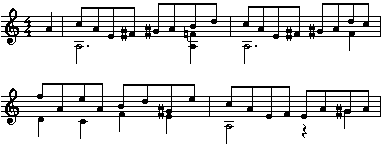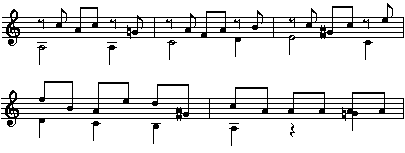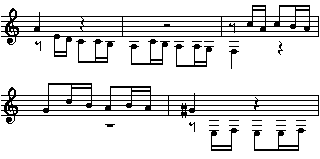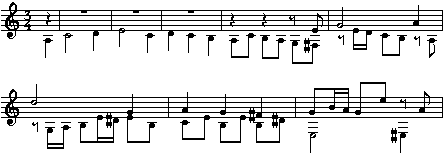Variacions
sobre un tema de Antonio de Cabezón. Edited
by Miguel Alcázar. London: Tecla Editions,
1982.
Timing:
6'
Grade: 5
Father Antonio
Brambila, an accomplished guitarist and Ponce's
friend and confessor, had long cherished a set of
variations by Antonio de Cabezón which he
had heard at an organ concert in Rome during 1924.
He gave Ponce a copy of the theme and asked him to
compose a set of variations for guitar, which Ponce
agreed to do. On February 8, 1948, two months
before his death, Ponce finished the work and
dedicated it to Father Brambila.
There are two
extant manuscript sources for this work, both in
the possession of Miguel Alcázar: the
autograph manuscript, consisting of a theme, six
variations and a fughetta; and a manuscript copy in
the hand of Father Antonio Brambila which contains
three additional variations. Father Brambila could
only definitely state that the additional
variations were by Ponce, but was unclear about any
other details.1 Alcázar comments
on the musical incongruities of the additional
variations with the rest of the work:
The
so-called variation VII, being in G major,
disturbs the tonal unity of the work [A
minor], has no thematic relationship with
the material which precedes it, and employs a
different harmonic language, so that it could in
fact be a kind of interlude. . . . Variation IX
would be a sort of coda, using a chromatic
descending scale; yet such a scale had already
been used—or would be used at the end of the
fughetta.2
Due to the absence
of these variations from the autograph, their
unknown source and musical incongruities, the
autograph will be treated as the definitive version
for this discussion. In addition to the
inconsistent state of the manuscript sources, there
are questions concerning the authorship of the
theme. Father Brambila attributed the theme of this
work to Cabezón; Alcázar, unable to
find the theme in Cabezón's published works,
traced the theme to the Liber Usualis Missae et
Oficii where it appears as an Easter hymn, "O
Filii et Filiae."3
The general tone of
this work is lean, somber and neoclassical,
although not as austere as Dos Viñetas. The
plainsong theme, consisting of two eight-measure
periods, is presented in a metrical setting (3/4)
and is simply harmonized:
Ex. 54.
Variacions sobre un tema de Antonio de
Cabezón, Theme, p. 1, mm. 1-4

Variations I
through V retain the phrase structure and length of
the theme, and the entire piece utilizes the tonal
center of A. Only in the sixth variation does Ponce
extend the length of the variation. To a degree not
seen in the two other sets of variations, Ponce
draws almost exclusively on the techniques of the
eighteenth-century melodic variation form with
fixed harmony.
Variation I mainly
utilizes a straightforward presentation of
arpeggios and passing tones to vary the
theme:
Ex. 55.
Variacions sobre un tema de Antonio de
Cabezón, Variation I, p. 1, mm.
1-4

The second
variation joins directly to the first variation via
a short transition, and is built around a rhythmic
pattern introduced in the bass voice:
Ex. 56.
Variacions sobre un tema de Antonio de
Cabezón, Variation II, p. 2, mm.
1-4

Variation III
utilizes block chords and open string pedal tones
(A and e1) as a means of contrast:
Ex. 57.
Variacions sobre un tema de Antonio de
Cabezón, Variation III, p. 2, mm.
1-4

The fourth
variation is a simple block chord harmonization of
the theme in the parallel major:
Ex. 58.
Variacions sobre un tema de Antonio de
Cabezón, Variation IV, p. 2, mm.
1-4

Variation V
exploits broken chord figuration in the manner of
style brisé:
Ex. 59.
Variacions sobre un tema de Antonio de
Cabezón, Variation V, p. 3, mm.
4-8

The final and most
inventive variation, no. VI, is based on the
rhythmic pattern introduced in Variation
II:
Ex. 60.
Variacions sobre un tema de Antonio de
Cabezón, Variation VI, p. 3, mm.
15-19

The Fughetta,
largely in two voices, is relatively brief and
consists only of an exposition, episode and coda.
The subject is based on the first phrase of the
theme:
Ex. 61.
Variacions sobre un tema de Antonio de
Cabezón, Fughetta, p. 4, mm. 1-8

The countersubject,
which is first heard during the entry of the real
answer at m. 5, is derived from the rhythmic motive
heard earlier in variations II and VI. The four
additional entries of the subject all appear with
the countersubject. The coda, in A phrygian, begins
with the subject harmonized in block chords over an
A pedal. Following a dramatic passage based on a
descending chromatic line, the work comes to rest
on a phrygian cadence of bII I. Although this work
is a startling contrast from the impressionistic
harmonies and virtuosic passage work of the
Théme varié et finale, it has
an unique charm of its own and should prove
especially inviting to students due to its moderate
technical and musical demands.
Footnotes
1Critical
notes from Manuel M. Ponce, Variations on a
Theme of Cabezón, edited by Miguel
Alcázar (London: Tecla Editions, 1982), pp.
iii-iv.
2Ibid.
3Ibid.